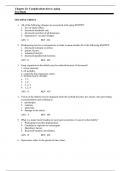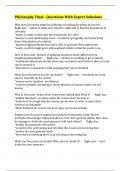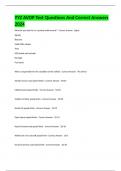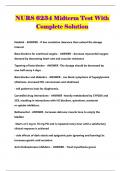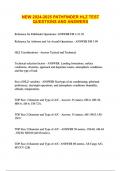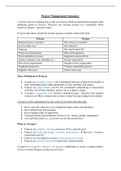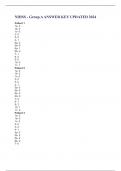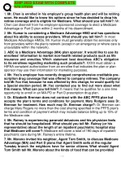Current and charge
charge: the amount of -positiveness charge : A£S
and negativeness conlombs; C
Amps; A
c
current: flow of charge A=
unit
I s
¢Q
Quantity I=
¢t
Net charge
Q = §ne
Q is the net
charge, n is the
number of electrons
and e is the elementary
charge
we describe the charge
on an object as being quantised
too
standard
A
circuit v
, Current: flow of charge measured in A
Charge: amount of positiveness Q
Resistance: difficulty of current to flow «
Potential difference: A difference in electron energy level between two
points
V
Q = IT P = I 2R
E =VQ P =VI
V = IR W = V It
X X
"= pd
E = PT
For any point in an electrical circuit
,the total current going into a point
Moving charges
Free electrons: an electron in a metal that is not bound to an atom and is tree to
move. (delocolised).
conventional current: A model used to describe electric current in a circuit.
Travels from positive to negative and is the direction in which positive
charges travel.
ionic solution: An ionic compound dissolved in a liquid to form an electrolyte
Ion: is an atom that has gained or lost an electron so has a net charge
i
electrolytes: A liquid containing ions that are free to move so can conduct
electricity.
Most electrons
in metal atoms
remain fixed to
their atom. But a
small number are
free to move.
equalsa
The faster ions move through the metal the greater the current. A
the
greater number of electrons moving increase current
,total current going out.
Electric current in electrolytes
Liquids that carry an electric current are called called
electrolytes.the current is allow of ions not electrons.
Conservation of charge
Total charge can not be
created or destroyed, it is
possible to make a positive
charge only if you make a
negative charge at the same
time.
X X
Kirchhoff's law Iin = Iout
, Mean drift velocity
The average distance
Number of free I = nAve i
electrons per M 3
travelled by electrons per
unit time along the length Cross sectional area
of the wire of wire
Drift velocity
Charge on the
electron
If the cross-sectional area of a wire changes, so must the
drift velocity. The narrower the wire, the greater the drift
velocity must be in order for the current to be the same
Classification of materials
a
The number density is the number of free electrons per cubic
metre.The higher the number density the better the conductor.
Conductors have a very high
number density while insulators
have a very low number density
,Circuit symbols
component which has the
ability or “capacity” to
store energy in the form
of an electrical charge
producing a potential
difference (Static Voltage)
across its plates
Allows current to flow in one direction
Resistance decreases as light intensity increases
, The volt
One volt is the potential difference across a component
when One joule of energy is transferred per unit charge
passing through the component V = JC ¡1
W
V =
Q
The voltmeter
An ideal voltmeter should have infinite resistance so that
when connected no current passes through the voltmeter
itself. However, voltmeters have a resistance of seven
million ohms
Electromotive force (emf)
When work is done on the charge carriers. A transfer of
energy to the charge carriers from the battery, transferring
other forms of energy into electrical energy.
Potential difference
When work is done by the charge carriers. A transfer of energy
from the charge carriers to the component, transferring electrical
energy into other forms.
Internal resistance
The cell loses power To thermal energy inside of it which acts as resistance
charge: the amount of -positiveness charge : A£S
and negativeness conlombs; C
Amps; A
c
current: flow of charge A=
unit
I s
¢Q
Quantity I=
¢t
Net charge
Q = §ne
Q is the net
charge, n is the
number of electrons
and e is the elementary
charge
we describe the charge
on an object as being quantised
too
standard
A
circuit v
, Current: flow of charge measured in A
Charge: amount of positiveness Q
Resistance: difficulty of current to flow «
Potential difference: A difference in electron energy level between two
points
V
Q = IT P = I 2R
E =VQ P =VI
V = IR W = V It
X X
"= pd
E = PT
For any point in an electrical circuit
,the total current going into a point
Moving charges
Free electrons: an electron in a metal that is not bound to an atom and is tree to
move. (delocolised).
conventional current: A model used to describe electric current in a circuit.
Travels from positive to negative and is the direction in which positive
charges travel.
ionic solution: An ionic compound dissolved in a liquid to form an electrolyte
Ion: is an atom that has gained or lost an electron so has a net charge
i
electrolytes: A liquid containing ions that are free to move so can conduct
electricity.
Most electrons
in metal atoms
remain fixed to
their atom. But a
small number are
free to move.
equalsa
The faster ions move through the metal the greater the current. A
the
greater number of electrons moving increase current
,total current going out.
Electric current in electrolytes
Liquids that carry an electric current are called called
electrolytes.the current is allow of ions not electrons.
Conservation of charge
Total charge can not be
created or destroyed, it is
possible to make a positive
charge only if you make a
negative charge at the same
time.
X X
Kirchhoff's law Iin = Iout
, Mean drift velocity
The average distance
Number of free I = nAve i
electrons per M 3
travelled by electrons per
unit time along the length Cross sectional area
of the wire of wire
Drift velocity
Charge on the
electron
If the cross-sectional area of a wire changes, so must the
drift velocity. The narrower the wire, the greater the drift
velocity must be in order for the current to be the same
Classification of materials
a
The number density is the number of free electrons per cubic
metre.The higher the number density the better the conductor.
Conductors have a very high
number density while insulators
have a very low number density
,Circuit symbols
component which has the
ability or “capacity” to
store energy in the form
of an electrical charge
producing a potential
difference (Static Voltage)
across its plates
Allows current to flow in one direction
Resistance decreases as light intensity increases
, The volt
One volt is the potential difference across a component
when One joule of energy is transferred per unit charge
passing through the component V = JC ¡1
W
V =
Q
The voltmeter
An ideal voltmeter should have infinite resistance so that
when connected no current passes through the voltmeter
itself. However, voltmeters have a resistance of seven
million ohms
Electromotive force (emf)
When work is done on the charge carriers. A transfer of
energy to the charge carriers from the battery, transferring
other forms of energy into electrical energy.
Potential difference
When work is done by the charge carriers. A transfer of energy
from the charge carriers to the component, transferring electrical
energy into other forms.
Internal resistance
The cell loses power To thermal energy inside of it which acts as resistance

